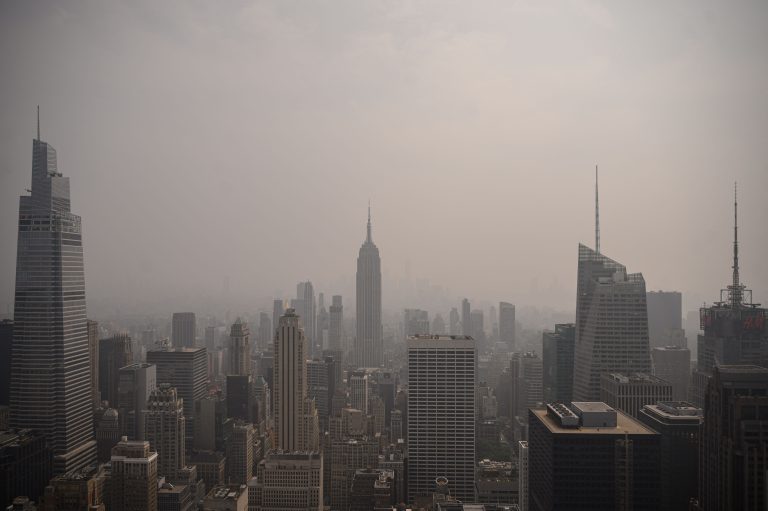On Aug. 14, New Yorkers woke up to a familiar haze blanketing the city, smoke that has drifted south from Canada due to wildfires.
Forecasters are saying that the light smoke, which was visible in parts of New Jersey and New York City Wednesday morning, will linger for several more days.
“You may notice hazy skies today. It is coming from wildfire smoke, which has overspread across the area from north to south. We expect this to stick around for the next several days,” the National Weather Service wrote on X, adding that the agency is not expecting any “harmful impacts to air quality, at this time.”
The National Weather Services New York Office, which serves the City, Long Island, New Jersey and parts of Connecticut listed air quality in these areas as “moderate,” while air quality in the Hudson Valley was rated “good.”
Some New Yorkers reported smelling smoke Wednesday morning, reminding them of the hazy days last summer when a similar scenario unfolded when Canada recorded its worst wildfire season on record.
Success
You are now signed up for our newsletter
Success
Check your email to complete sign up
At that time, hundreds of fires forced the evacuation of an estimated 235,000 people across a number of Canadian provinces and blanketed the Big Apple in a thick rust-colored haze. The widespread smoke prompted health advisories in multiple cities in the United States.
READ MORE:
- NYC’s Trees May Be Making Air Quality Worse, Not Better, Researchers Say
- Chinese Academic Wang Shujun Found Guilty of Working as Communist Agent to Infiltrate Democracy Movement
- Spike in Drownings at NYC Beaches Prompts City Authorities to Act
Wildfire smoke health impacts
Wildfire smoke can be carried thousands of miles away from its source, impacting air quality and subsequently people’s health far away from the actual fire.
Wildfire smoke is a mix of gasses, particles and water vapor that contains ozone, methane, sulfur dioxide, nitrogen dioxide, carbon monoxide, volatile organic compounds (VOCs), fine particulate matter (PM2.5), and polycyclic aromatic hydrocarbons (PAHs).
The particulate matter is considered the main health risk and the most harmful.
According to Health Canada “There’s no known safe level of exposure for some of these pollutants. This means that smoke can impact your health even at very low levels.”
Exposure to these particulates can cause headache, a mild cough, the production of mucus and nose, throat, eye and sinus irritation. Most of the time, medical intervention is not required.
However, more serious, and less frequent symptoms include dizziness, wheezing, chest pains, severe cough, asthma attacks, shortness of breath, and heart palpitations.
If any of these symptoms are experienced, one should speak with their healthcare provider.
In very rare cases exposure to wildfire smoke can cause, stroke, heart attack, premature death and reproductive and developmental effects, such as low birth rate.
READ MORE:
- Social Media Warfare: Inside the CCP’s Campaign to Smear Falun Gong, Shen Yun
- West Nile Virus Infected Mosquitoes Found in Every NYC Borough, Officials Say
- Elon Musk’s Trump Conversation Attracts Over 16 Million Listeners Despite Online Attacks
Protect your health
To protect yourself from wildfire smoke, stay up-to-date on what the local air quality is like in your region.
Limit time outdoors and listen to your body. If you are experiencing symptoms of wildfire smoke exposure, take action and find somewhere in doors with good ventilation to stay.
People who are most susceptible to wildfire smoke include the elderly, people who smoke, Indigenous people, infants and young children, pregnant women, and people involved in strenuous outdoor exercise or work, among others.
If you can, reduce or reschedule strenuous outdoor activities and seek medical attention if experiencing any serious symptoms.
Avoid participating in outdoor events and activities.
To protect your indoor air quality, keep windows and doors closed as much as possible, however, if there is extreme heat, prioritize keeping cool.
If using an air filter in your ventilation system, ensure it’s operating within the manufacturer’s recommendations.
You can always use a portable air cleaner that can filter fine particles but, be sure to change filters on a regular basis.
Always check with your healthcare provider to determine what is best for your individual situation.







